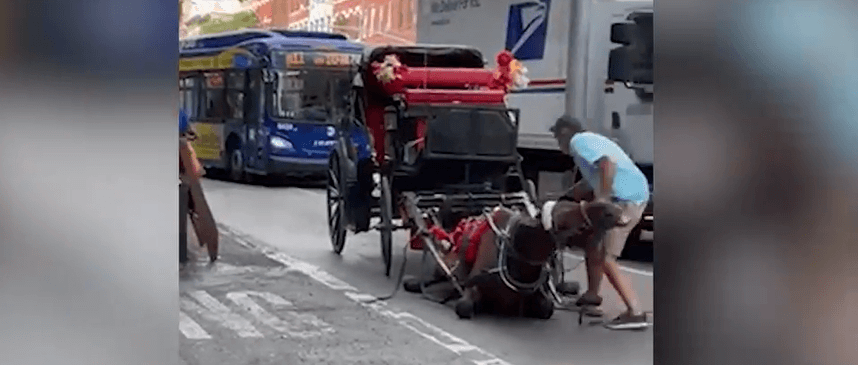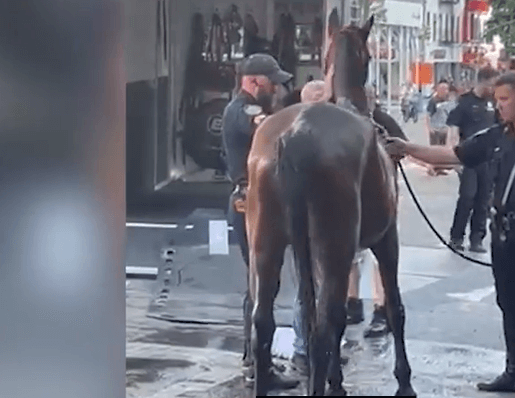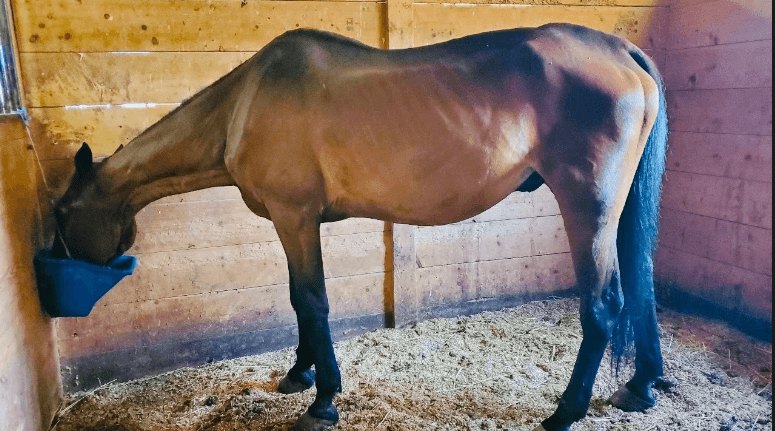Ryder, the carriage horse seen on viral videos across social media collapsing on a Manhattan street, has renewed calls for a ban on horse-drawn carriage horses in the city, Fortunately for Ryder, he has now been retired to a private farm in upstate New York.

According to Pix11News, in the two weeks since the horse collapsed along a Hell’s Kitchen street, Ryder has been turned over to his new owners who are making sure the horse is beginning treatment for EPM, (Equine Protozoal Myeloencephalitis), a parasitic infection. The condition, believed to be caused by possum droppings, caused Ryder to stumble and fall. Once he had fallen, the horse had a difficult time getting back on his feet and suffered leg abrasions, a cut on his neck and bruises on his knees.

The Transport Workers Union, that represents horse carriage drivers, stated Ryder is being administered a course of antibiotics and will be receiving further veterinarian care.
Although the horse was thought to be 13-years-old, documentation has proven the horse is really 26-years-old which is too old to be licensed as a carriage horse in New York City. He had previously been owned by a Pennsylvania farmer and used as a buggy horse.
The viral video showed the driver hit Ryder with a small whip to get the horse back on his feet, but when that didn’t work, the New York Police Department doused him with water and ice – thinking the horse had overheated from the rising temperatures. Eventually, the horse was able to stand up again and walked back to the stable.
The Transport Workers Union is promoting better safety protocol to insure the condition of the carriage horses. Horses will receive bi-weekly medical checks of their hearts, and a committee will be intervening on health and safety matters for the protection of the horses.
Follow the National Pet Rescue on Facebook for the latest animal related news.




Happy for Ryder. He was too old to pull pull a buggy and he was too old to pull a carriage. Their union is talking out both sides of their mouths right now promising all the changes for the horses but they say it every time a horse goes down. Once people forget they go right back to mistreating the horses, till the next horse goes down injured or dies! They keep these poor horses in old moldy tenement building that are full of mice, opossums and rats. Opossum feces in their food and water can cause permanent neurological condition in the host. This horse was nearly starved to death because he probably wouldn’t eat the food full of pee and poop.
Equine Protozoal Myeloencephalitis
The most common symptoms of EPM are ataxia, general weakness with muscle spasticity. However this is not specific to EPM and is common to many other neurological disorders. Clinical signs among horses with EPM include a wide array of symptoms that may result from primary or secondary problems. Some of the signs are difficult to distinguish from other problems, such as lameness, which can be attributed to many different causes. Apparent lameness, particularly atypical lameness or slight gait asymmetry of the rear limbs are commonly caused by EPM. Focal muscle atrophy, or even generalized muscle atrophy or loss of condition may result. Secondary signs also occur with neurologic disease. Airway abnormalities, such as laryngeal hemiplegia, snoring, or airway noise of undetermined origin may result from damage to the nerves which control the throat, although this is quite uncommon.
In experimentally infected horses, very early signs included loss of appetite, decreased tongue tone, facial paresis, altered mental status, generalized weakness, and lameness.
It is thought that Sarcocystis neurona does not need to enter the CNS to cause disease, in some cases S. neurona has been found in the CNS but usually not. In cases where S. neurona is found in the CNS, white blood cells probably play a role in the parasite’s penetration of the blood brain barrier. https://en.wikipedia.org/wiki/Equine_protozoal_myeloencephalitis
Poor Ryder was showing signs for weeks but his illness was ignored.
MANY MANY MANY THANKS TO THE TRANSPORT UNION HEROES AND ANGELS!
IT IS FINALLY TIME FOR RYDER TO RECEIVE THE DEEPEST LOVE AND GREATEST CARE HE DESERVES! ARE DONATIONS NEEDED?